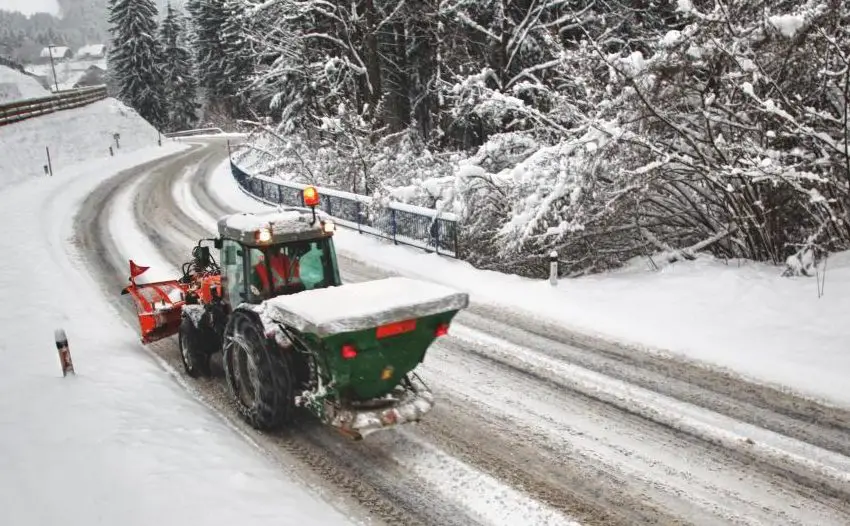Sodium chloride has been used to de-ice roads since the 1940s, but concerns about the costs to taxpayers and impacts on the environment has communities reconsidering its usage. Perhaps municipalities could learn from states that have drastically cut their salt consumption during the winter months despite having more winter than everyone else, such as Alaska.
The past decade has seen harsh winters that resulted in shortages of salt. According to Michael Sproul, a Wisconsin engineer, the ‘07-‘08 winter was a doozie. When the typical seasonal allowance of sodium chloride ran out, the state had to buy tons more at three times the usual cost.
There was another such shortage in 2014, and Wisconsin and other areas had to adapt their salt usage. Wisconsin already typically spent a few million dollars on sodium chloride for the winter.
Nathan Riggs, spokesperson for the state’s Department of Transportation, says Indiana typically spends $33 million annually on road salt. In contrast, Alaska spends roughly $400,000 and may even be able to minimize these costs entirely because of their optimization of sand in de-icing roads rather than using salt. In addition to saving communities millions in taxes annually, sanded roads could potentially avoid harmful environmental impacts.
The Dangers of Salt
One of the most visible results of salted roads is the corrosion it causes on the bodies of cars. However, that is not the end of the story. Salt, when used as de-icing agent on surface, may cause negative impacts on the environment. Water contamination is one of the main reasons why Alaska, which is sensitive to dangers to its salmon, move away from sodium chloride toward sand.
Victoria Kelly, an expert at New York’s Cary Institute of Ecosystem Studies, reports “road salt is accumulating in our waterways.” The Proceedings of the National Academy of Sciences say that within 50 years, if habits do not change, “many lakes will exceed the aquatic life threshold criterion for chronic chloride exposure” as dictated by the Environmental Protection Agency.
Limiting Salt
While communities are conscious of the dangers of sodium chloride, most do not avoid it entirely. Instead, they may spray a mixture of salt and organic matter to keep it stuck to the street so that it will not get washed away regularly. Usually these mixtures contain beet juice, but some eastern states use molasses. Others employ beer or pickle waste, and a county or two in Wisconsin even tried cheese brine.
One of Beet 55’s salespeople claims that the product can “cut your salt usage by a third, saving people some money in the long run.” BEET HEET, a mixture of sodium chloride and liquefied sugar beet molasses, was used in Pennsylvania and three other states. Their Department of Transportation’s spokesperson, Jamie Legenos, praised the new de-icing medthod, “We have seen positive results using the product at temperatures below 15 degrees where salt is not as effective.”
That 15 degree point explains why Alaska, with frequent sub-zero temperature, avoids salt. Contrary to its original purpose, when the temperature dips that low, salt makes roads even more dangerous, which forced the state that is frozen eight months out of the year to deal with ice in a different way than many places.
Alaska’s Solution
The Last Frontier knows the dangers of salted roads and instead employs sand on their streets. In addition to corroding vehicles, sodium chloride kills vegetation, can draw moose to highways and may pollute salmon streams. Most importantly, when the temperature dips below 15 degrees, water can mix with sodium chloride and refreeze into what the local road workers affectionately call “chemical ice.”
The chief of maintenance for the Department of Transportation, Jack Fullerton, explains the danger of chemical ice, “It’s even more difficult to get off the road than regular ice. So we don’t use salt products to de-ice the roads. They aren’t effective.” So, instead of de-icing roads, salt is used in Alaska for a very different purpose: unfreeze the true salvation of the Alaskan winter motorist — sand.

Sand de-iced with salt is applied to highways and major roads in the city, while residential and secondary areas receive sand mixed with small amounts of a less harsh salt. However, the downtown area and a dangerous stretch of highway are doused in potassium acetate. Those high-traffic areas are particularly hazardous, so it is fortunate that the compound functions effectively under sub-zero temperature and that the locations where it is applied are distant from sensitive environmental zones.
In the spring, road crews collect the sand and store it in massive piles. The next year, the gravel is reused, and the state of Alaska almost completely avoids buying road salt, a potentially expensive commodity.
Going Salt-Free
Alaska makes cost-effective and environmentally safe decisions when they respond to icy roads, even though potassium acetate is more expensive than standard salt and could potentially be harmful to wildlife. According to Caleb Dobbins, a highway engineer in New Hampshire, such substitutes can cost thirty times more and may still harm the environment. However, Alaska only uses it in high-traffic areas or zones that are particularly dangerous.
Some in Anchorage seek to do away with sodium chloride entirely. After all, salt is only used to unfreeze the main de-icing agent, sand, so all they have to do to replace salt is to prevent sand from freezing.The Department of Transportation’s Tom Grman supports the plan of building a heated storage area to house the sand, claiming “If we had indoor storage, I wouldn’t be spending $400,000 a year on salt.”
At the end of the winter, the sand is collected, and Alaska saves money while making sure their icy roads are safe to drive on. Other parts of the country could learn from the trials of the northern-most state. Substituting salt for sand could save money, slow the corrosion of vehicles and protect aquatic life. Besides, certainly sand has to smell better than liquefied beets or cheese brine.
















